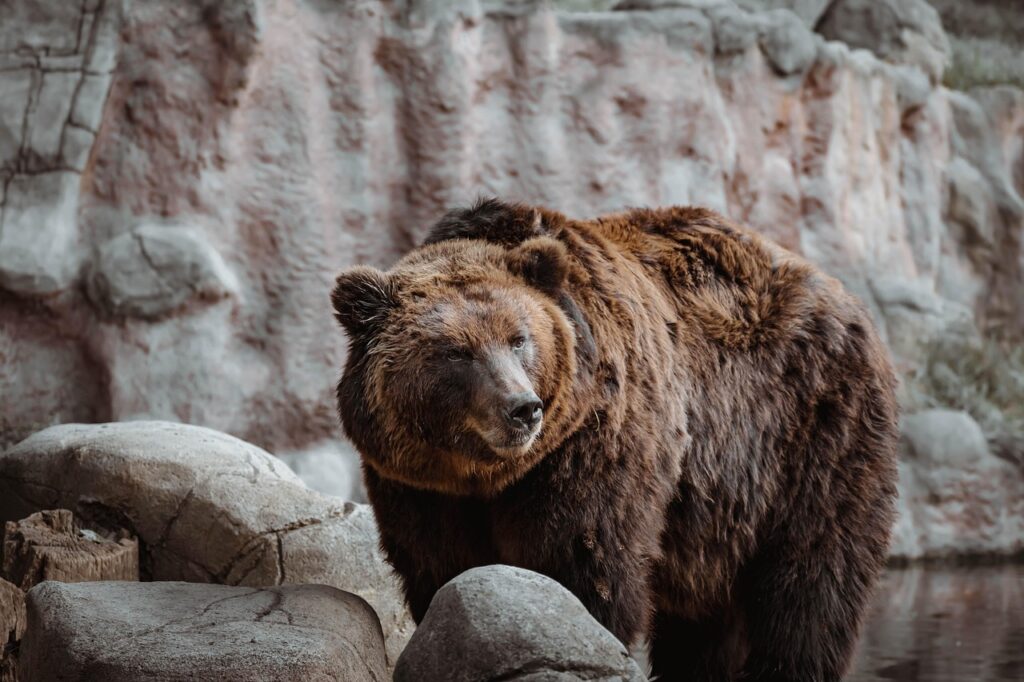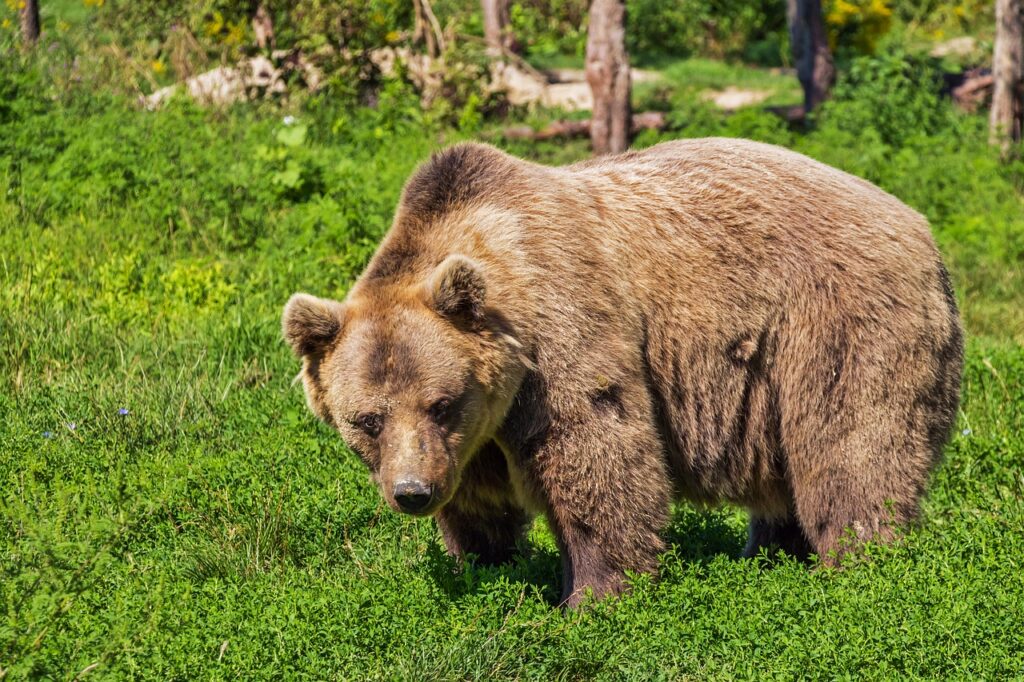Discover the fascinating world of bears: their habitats, behaviors, and conservation efforts. Learn about these majestic wild creatures today!
When you think of bears, what comes to mind? Perhaps it’s their powerful physique, their reputation as skilled hunters, or even their surprising love for berries. Bears are among the most fascinating creatures in the animal kingdom. From their varied habitats to their unique behaviours, there’s so much to uncover about these majestic animals.
Let’s dive into the world of bears and explore their species, habitats, diets, behaviours, and conservation efforts. This guide will help you understand why bears are so captivating and how we can protect them for future generations.

Types of Bears: A Diverse Family
The bear family, scientifically known as Ursidae, consists of eight distinct species spread across different parts of the world:
- Brown Bear (Ursus arctos): Found in North America, Europe, and Asia, brown bears are known for their adaptability and sheer size. Subspecies include the grizzly bear and the Kodiak bear.
- Polar Bear (Ursus maritimus): Native to the Arctic, polar bears are marine mammals that rely heavily on sea ice to hunt seals.
- American Black Bear (Ursus americanus): The most common bear species in North America, these bears exhibit a wide variety of colours, from black to cinnamon.
- Asian Black Bear (Ursus thibetanus): Often called moon bears due to the crescent-shaped patch on their chest, they inhabit forests across Asia.
- Panda Bear (Ailuropoda melanoleuca): Perhaps the most iconic bear, giant pandas are native to China and have a diet consisting almost exclusively of bamboo.
- Sloth Bear (Melursus ursinus): Found in the Indian subcontinent, sloth bears have a unique diet of termites and ants.
- Spectacled Bear (Tremarctos ornatus): The only bear species native to South America, they’re named for the distinctive markings around their eyes.
- Sun Bear (Helarctos malayanus): Known as the smallest bear species, sun bears inhabit tropical forests in Southeast Asia.
Where Do Bears Live? Their Diverse Habitats
Bears are incredibly adaptable, thriving in a range of habitats, including:
- Forests: Many species, like the American black bear and Asian black bear, call dense forests home.
- Arctic Regions: Polar bears are uniquely adapted to the icy environments of the Arctic, with thick fur and layers of fat for insulation.
- Mountains: Brown bears and spectacled bears are often found in mountainous regions.
- Tropical Forests: Sun bears and sloth bears inhabit the lush tropical forests of Asia.
- Grasslands and Meadows: Grizzly bears often venture into open grasslands in search of food.
Each habitat provides the resources these animals need to survive, including food, shelter, and water. However, habitat loss remains one of the biggest threats to their survival.

What Do Bears Eat? A Look at Their Diets
Bears are omnivores, which means their diet includes both plants and animals. However, their food preferences can vary significantly based on species and location:
- Brown Bears: They have a diverse diet that includes fish (especially salmon), berries, roots, and small mammals.
- Polar Bears: As apex predators, their diet consists mainly of seals, though they’ll scavenge on whale carcasses or hunt birds when necessary.
- American Black Bears: These bears consume fruits, nuts, insects, and occasionally small animals.
- Panda Bears: Remarkably, 99% of their diet is bamboo, though they’ll eat small rodents or birds if available.
- Sloth Bears: They use their long snouts to suck up termites and ants, supplemented by fruits.
Their dietary habits play a crucial role in the ecosystem, as they help control prey populations and disperse seeds through their scat.
Unique Behaviours of Bears
Bears exhibit a range of fascinating behaviours that make them truly unique in the animal kingdom:
- Hibernation:
- Species like brown bears and American black bears hibernate during winter, slowing their metabolism to conserve energy. This is not true for polar bears, which remain active year-round.
- Swimming:
- Polar bears are excellent swimmers, capable of covering long distances to find food or ice. Brown bears and black bears are also strong swimmers, often seen fishing in rivers.
- Climbing:
- Black bears and sun bears are skilled climbers, using trees for safety or to forage for food.
- Communication:
- Bears communicate through vocalizations, body language, and scent markings. For example, a mother bear’s growl warns her cubs of potential danger.
- Playfulness:
- Cubs often engage in playful wrestling, which helps them develop survival skills.
Threats to Bears: Challenges They Face
Despite their strength and adaptability, bears face numerous threats in the wild:
- Habitat Loss: Urbanization, deforestation, and climate change are shrinking their habitats.
- Poaching: Bears are hunted for their fur, bile, and other body parts, particularly in parts of Asia.
- Human-Wildlife Conflict: As humans encroach on bear territories, encounters often lead to negative outcomes for bears.
- Climate Change: For polar bears, the melting of sea ice is a critical issue, affecting their ability to hunt and breed.
Conservation Efforts: Protecting Bears
Conservationists and governments worldwide are working to protect bears and their habitats:
- Protected Areas: Establishing national parks and wildlife reserves to safeguard bear habitats.
- Anti-Poaching Laws: Strengthening regulations to prevent illegal hunting and trading of bear parts.
- Wildlife Corridors: Creating pathways to connect fragmented habitats, allowing bears to roam freely.
- Education and Awareness: Teaching communities about coexistence and the importance of bears in the ecosystem.
- Climate Action: Addressing climate change to protect species like polar bears.

How You Can Help
You don’t have to be a wildlife expert to make a difference. Here are some simple steps to support bear conservation:
- Support Conservation Organizations: Donate to or volunteer with groups like WWF or the International Bear Association.
- Be a Responsible Tourist: Follow guidelines when visiting bear habitats to avoid disturbing them.
- Reduce Your Carbon Footprint: Help combat climate change by adopting sustainable practices.
- Spread Awareness: Share information about bears and their importance to encourage others to take action.
Why Bears Matter
Bears play a vital role in maintaining the balance of their ecosystems. By controlling prey populations, dispersing seeds, and shaping their habitats, they contribute to the health of the environment. Beyond their ecological significance, bears also hold cultural and spiritual importance in many societies, symbolizing strength, resilience, and connection to nature.
Final Thoughts
Bears are more than just powerful predators; they’re intricate and vital members of the animal kingdom. By understanding their behaviours, habitats, and challenges, we can foster a deeper appreciation for these magnificent creatures. Let’s work together to ensure that future generations can marvel at the beauty and majesty of bears in the wild.
What’s your favourite bear species, and why? Share your thoughts in the comments below—we’d love to hear from you!
Adorable Alert! 🧸 This tiny teddy in a pink dress is the ultimate cuddle buddy—perfect for gifting or keeping! Click to see why everyone loves it!